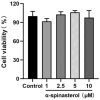α-spinasterol isolated from Achyranthes aspera L. ameliorates inflammation via NF-κB and Nrf2/HO-1 pathways
- PMID: 39962315
- PMCID: PMC11833118
- DOI: 10.1038/s41598-025-90022-2
α-spinasterol isolated from Achyranthes aspera L. ameliorates inflammation via NF-κB and Nrf2/HO-1 pathways
Abstract
On the basis of previous studies, the low-polar part of Achyranthes aspera L. (A. aspera) had strong anti-inflammatory activity. Three compounds were isolated from the low polarity fraction of A. aspera, and their structures were identified as α-spinasterol (1), 7,8-dihydrospinasterol (2), 22,23-dihydrospinasterol (3). Among them, the content of α-spinasterol (1) in A. aspera was higher in the spring and winter seasons through HPLC methods, ranging from 0.0085 to 0.0157%. Futhermore, in the LPS-induced RAW264.7 cells inflammation model, α-spinasterol significantly reduced the levels of cytokines such as IL-6, PGE2 and TNF-α, inhibited the expression of COX-2, 5-LOX, p-IKKβ, p-NFκB and p-IkBα proteins, and promoted the expression of Nrf2, HO-1 and NQO1 proteins. Therefore, this study showed that α-spinasterol can inhibit LPS-induced RAW264.7 cells inflammation, and its mechanism may be related to the inhibition of NF-κB pathway, activation of Nrf2 pathway, and reduction of excessive release of inflammatory factors.
Keywords: Anti-inflammatory; Content determination; NF-κB; Nrf2; α-Spinasterol.
© 2025. The Author(s).
Conflict of interest statement
Declarations. Competing interests: The authors declare no competing interests.
Figures








References
-
- Medzhitov, R. Origin and physiological roles of inflammation. Nature454, 428–435 (2008). - PubMed
-
- Na, Y. R., Stakenborg, M., Seok, S. H. & Matteoli, G. Macrophages in intestinal inflammation and resolution: A potential therapeutic target in IBD. Nat. Rev. Gastroenterol. Hepatol.16, 531–543 (2019). - PubMed
MeSH terms
Substances
Grants and funding
- No.3 [2018]/the first-class construction discipline of Chinese materia medica of Hunan University of Traditional Chinese Medicine
- 2022JJ40315/the Natural Science Foundation of Hunan Province
- 2021JJ30500/the Natural Science Foundation of Hunan Province
- 21B0390/the Research Foundation of Education Bureau of Hunan Province
- 23A0303/the Research Foundation of Education Bureau of Hunan Province
LinkOut - more resources
Full Text Sources
Research Materials
Miscellaneous

